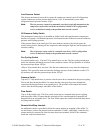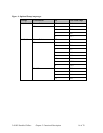2-40 HP Portable Chillers Chapter 2: Functional Description 9 of 78
2-2 General Description
Our portable chillers are reliable, accurate, and easy to use process cooling units. They are
available in air-, water-, and remote air-cooled designs in a range of sizes from 2 to 40 tons.
All are self-contained, fully portable and shipped ready to use. (Remote air-cooled chillers
require field installation by qualified technicians.)
Standard range of operation is 30ºF to 65ºF (-1ºC to 18ºC) for applications using a
water/glycol mix and 45ºF to 65ºF (7º to 18ºC) for water only applications.
A factory installed crankcase pressure regulating valve option is available for processes
requiring a leaving water temperature of up to 75ºF (24ºC).
Chilled Water Circuit
Cooling water “To Process” and “From Process” connections are made at the gate valves
provided outside the unit. Warm coolant (water and glycol mixture) returns from the process
and goes into the reservoir tank. The coolant is then pumped through the evaporator where it
is cooled. The coolant flows to the process and returns to repeat the cycle.
A pressure actuated process water bypass valve located between the supply line and reservoir
tank (single pump models only) allows minimal flow through the unit during the intermittent
fluctuating flow conditions. It is not intended to provide continuous full bypass flow.
This minimal flow allows the temperature sensor to signal the controller to shut down the
compressor because of the drop in process water temperature. Typically the flow switch shuts
down the chiller in this low flow condition.
The 2 hp and 3 1/2 hp models have a 1/4” poly-tubing constant bypass to provide additional
process water bypass to prevent system freeze-up.
Refrigeration Circuit
Air-, water-, and remote air-cooled refrigerant condensing differs only in the way the
compressed gas is condensed to a liquid.
Liquid refrigerant from the condenser heat exchanger flowing in the liquid line passes
through a shut-off valve (5 hp to 40 hp chillers only) into a filter/dryer that removes moisture
and other contaminants. A refrigerant sight glass is provided. The refrigerant then passes
through the thermal expansion valve, which allows the refrigerant to expand (boil off) and
cool the fluid inside of the evaporator. The refrigerant gas flows through the suction linen
back into the compressor.
The refrigerant is compressed in the compressor and flows through the discharge line as a gas
to the condenser. There it gives up its heat as it condenses to a liquid in the condenser.
A hot gas bypass valve is used to control cooling capacity during intermittent or partial load
conditions. This feature contributes substantially to chiller longevity by eliminating excessive
cycling of the compressor and providing close temperature control.


















